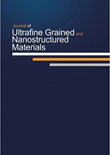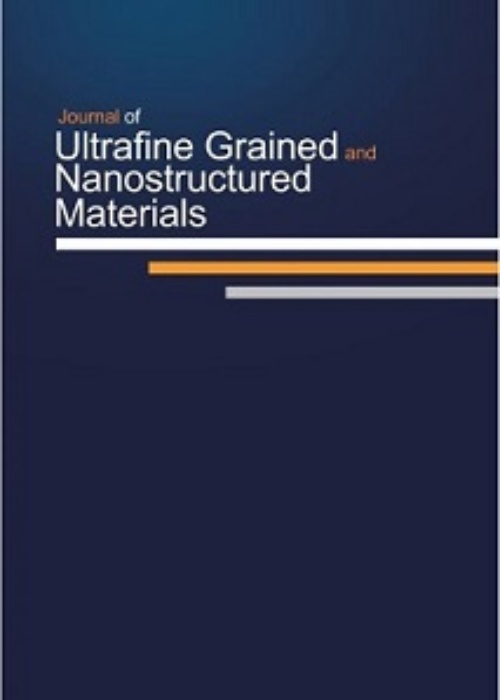فهرست مطالب

Journal of Ultrafine Grained and Nanostructured Materials
Volume:48 Issue: 1, Jun 2015
- تاریخ انتشار: 1394/05/11
- تعداد عناوین: 8
-
-
Pages 1-4In this paper, plate-like NiO nanoparticles were prepared by one-pot solid-state thermal decomposition of nickel (II) Schiff base complex as new precursor. First, the nickel (II) Schiff base precursor was prepared by solid-state grinding using nickel (II) nitrate hexahydrate, Ni(NO3)2∙6H2O, and the Schiff base ligand N,N′-bis-(salicylidene) benzene-1,4-diamine) for 30 min without using any solvent, catalyst, template or surfactant. It was characterized by Fourier Transform Infrared spectroscopy (FT-IR) and elemental analysis (CHN). The resultant solid was subsequently annealed in the electrical furnace at 450 °C for 3 h in air atmosphere. Nanoparticles of NiO were produced and characterized by X-ray powder diffraction (XRD) at 2θ degree 0-140°, FT-IR spectroscopy, scanning electron microscopy (SEM) and transmission electron microscopy (TEM). The XRD and FT-IR results showed that the product is pure and has good crystallinity with cubic structure because no characteristic peaks of impurity were observed, while the SEM and TEM results showed that the obtained product is tiny, aggregated with plate-like shape, narrow size distribution with an average size between 10-40 nm. Results show that the solid state thermal decomposition method is simple, environmentally friendly, safe and suitable for preparation of NiO nanoparticles. This method can also be used to synthesize nanoparticles of other metal oxides.Keywords: Nickel (II) Schiff base precursor, NiO nanoparticles, prepared, SEM, TEM, XRD
-
Pages 5-10Cerium oxide (CeO2) or ceria has been shown to be an interesting support material for noble metals in catalysts designed for emission control, mainly due to its oxygen storage capacity. Ceria nanoparticles were prepared by precipitation method. The precursor materials used in this research were cerium nitrate hexahydrate (as a basic material), potassium carbonate and potassium hydroxide (as precipitants). The morphological properties were characterized by high resolution transmission electron microscopy (HRTEM), scanning electron microscopy (SEM) and X-ray diffraction (XRD), Fourier transform infrared spectroscopy (FTIR) and UV-Vis spectrophotometer. XRD results showed face centered cubic CeO2 nanoparticles for annealed nanoparticles at 1000°C. SEM measurement showed that by increasing the calcinations temperature from 200 to 600°C, the crystallite size decreased from 90 to 28 nm. The SEM results showed that the size of the CeO2 nanoparticles decreased with increasing temperature. The particle size of CeO2 was around 25 nm as estimated by XRD technique and direct HRTEM observation. SEM and TEM studies showed that the morphology of the prepared powder was sphere-like with a narrow size distribution. The sharp peaks in FTIR spectrum determined the purity of CeO2 nanoparticles and absorbance peak of UV-Vis spectrum showed the small band gap energy of 3.26 ev.Keywords: CeO2 nanoparticles, cerium (III) nitrate, precipitation, structure properties
-
Pages 11-16The evolution of texture was discussed during the formation of ultra-fine and nano grains in a magnesium alloy severely deformed through accumulative back extrusion (ABE). The microstructure and texture obtained after applying multiple deformation passes at temperatures of 100 and 250°C were characterized. The results showed that after single ABE pass at 100°C an ultrafine/nano grained microstructure was obtained, while the initial texture was completely replaced by a new fiber basal texture, inclined at 40°C to the transverse direction. As the processing temperature increased to 250°C, the obtained texture intensities were strengthened, though the c-axis of crystals gradually rotated towards the transverse direction and a <10-11> fiber texture parallel to normal direction was developed. Moreover, repetitive ABE was associated with the tendency of the basal plane to lie parallel to TD, while the orientation of the prismatic planes showed a random distribution around ND. After eight passes, the most noticeable texture obtained included the fiber basal texture oriented almost parallel to the transverse direction, and <10-10> perpendicular to the ED and <10-11> parallel to the ND. The maximum texture intensity decreased as the number of passes increased, which is attributed to strain path change involved during each consecutive ABE pass, as well as promoted the contribution of non-basal slip systems.Keywords: magnesium, nano recrystallization, texture
-
Pages 17-25CaZrO3 nanoceramics were successfully synthesized at 700 C using the molten salt method, and the effects of processing parameters, such as temperature, holding time, and amount of salt on the crystallization of CaZrO3 were investigated. CaCl2, Na2CO3, and nano-ZrO2 were used as starting materials. On heating, CaCl2–NaCl molten eutectic salt provided a liquid medium for the reaction of CaCO3 and ZrO2 to form CaZrO3. The results demonstrated that CaZrO3 started to form at about 600C and that, after the temperature was increased to 1,000C, the amounts of CaZrO3 in the resultant powders increased with a concomitant decrease in CaCO3and ZrO2 contents. After washing with hot distilled water, the samples heated for 3 h at 700C were single-phase CaZrO3 with 90–95 nm particle size. Furthermore, the synthesized CaZrO3 particles retained the size and morphology of the ZrO2 powders which indicated that a template mechanism dominated the formation of CaZrO3 by molten-salt method.Keywords: calcium zirconate, molten salt method, nanomaterials, template growth
-
Pages 27-35Fuel cells, secondary batteries and capacitors are among many promising energy storage devices. In particular, supercapacitors have attracted much attention because of their long life cycle and high power density. Graphene/nickel ferrite(G-NF) based supercapacitors were successfully fabricated through a one-step facile solvothermal route. Effects of synthesis conditions i.e. solvothermal time and temperature, on the powder particle characteristics were evaluated using x-ray photoelectron spectroscopy (XPS), powder x-ray diffraction (XRD) and high-resolution transmission electron microscopy (HRTEM). Fast Fourier transformation (FFT) patterns were also recorded on the HRTEM microscope to determine the lattice and crystallinity of the nanocomposites. Structural and chemical studies proved that increasing the solvothermal duration and temperature leads to improved crystallinity of NiFe2O4phase as well as higher degree of reduction of graphene oxide to graphene. The electrochemical measurements showed that solvothermal conditions of 180°C and 10h produces the highest specific capacity of 312 and 196 F g-1 at current densities of 1 and 5 A g-1, respectively calculated from charge-discharge test. This G-NF electrode material, also showed a capacity of 105 F g-1 after 1500 cycles at current density of 10 A g-1 which makes it an outstanding supercapacitor material with promising long cycle electrochemical stability and performance.Keywords: graphene, nanocomposite, NiFe2O4, solvothermal, supercapacitor
-
Pages 37-44A facile mechanochemical-based method for synthesis of copper oxide (CuO) nanoparticles is here by introduced. For this purpose, copper hydroxide powder was synthesized through a facile solution method (CuSO4 + 2 Na(OH) → Cu(OH)2 + Na2SO4) after which milling of as-prepared Cu(OH)2 precursor and NaCl resulted in the mechanochemical dehydration of Cu(OH)2 and dispersion of CuO nanoparticles into the salt matrix (Cu(OH)2+2NaCl=CuCl2+2NaOH and then CuCl2+2NaOH=CuO+2NaCl+H2O). Subsequently, washing the milled powders led to the removal of salt matrix and separation of CuO particles. The main advantages of the introduced method are synthesis of CuO nanoparticles with narrow size distribution without subsequent annealing during the process. The results of X-ray diffraction (XRD) indicated that the dehydration of Cu(OH)2 into CuO was completed after three hours of milling. Structural analysis using scanning electron microscopy (SEM) equipped with energy dispersive spectroscopy (EDS), transmission electron microscopy (TEM) and particle size analyzer (PSA) showed that CuO particles had moderately equiaxed shape with sizes ranging from 10-27 nm. Also, the results of UV–visible absorption spectroscopy indicated that CuO nanoparticles had a band gap of 2.5 eV.Keywords: mechanochemical, nanostructure, visible, ultraviolet spectrometers, TEM
-
Pages 45-52Nano-structured lanthanum strontium cobalt ferrite, La0.6Sr0.4Co0.2Fe0.8O3 (LSCF), was successfully synthesized via co-precipitation method using metal nitrates as starting materials. Effects of precipitating agent and calcination temperature on the phase composition and morphology of synthesized powders were systematically studied using X-ray diffraction (XRD) and field emission scanning electron microscopy (FESEM), respectively. XRD analysis revealed that a single phase La0.6Sr0.4Co0.2Fe0.8O3 perovskite was obtained in the processed sample using ammonium carbonate as precipitating agent with a NH4+/NO3-molar ratio of 2 after calcination at 1000C for 1 h. The phase composition of products was also affected by changing pH values. Moreover, using sodium hydroxide as a precipitant resulted in a mixture of La0.6Sr0.4Co0.2Fe0.8O3 and cobalt ferrite (CoFe2O4) phases. Careless washing of the precursors can also led to the formation of mixed phase after calcination of final powders. Mean crystallite size of the obtained powders was not noticeably affected by varying calcination temperature from 900 to 1050C and remained almost the same at 10 nm, however increasing calcination temperature to 1100C resulted in sharp structural coarsening. FESEM studies demonstrate that relatively uniform particles with mean particle size of 90 nm were obtained in the sample processed with a NH4+/NO3- molar ratio of 2 after calcination at 1000C for 1 h.Keywords: ammonium carbonate, co, precipitation, La0.6Sr0.4Co0.2Fe0.8O3, nanoparticles, solid oxide fuel cell
-
Pages 53-58Austenitic stainless steels are extensively used in various applications requiring good corrosion resistance and formability. In the current study, the formation of nano/ ultrafine grained austenitic microstructure in a microalloyed AISI 304L stainless steel was investigated by the advanced thermomechanical process of reversion of strain-induced martensite. For this purpose, samples were subjected to heavy cold rolling to produce a nearly complete martensitic structure. Subsequently, a wide range of annealing temperatures (600 to 800°C) and times (1 to 240 min) were employed to assess the reversion behavior and to find the best annealing condition for the production of the nano/ultrafine grained austenitic microstructure. Microstructural characterizations have been performed using X-ray diffraction (XRD), scanning electron microscopy (SEM), and magnetic measurement, whereas the mechanical properties were assessed by tensile and hardness tests. After thermomechanical treatment, a very fine austenitic structure was obtained, which was composed of nano sized grains of ~ 85 nm in an ultrafine grained matrix with an average grain size of 480 nm. This microstructure exhibited superior mechanical properties: high tensile strength of about 1280 MPa with a desirable elongation of about 41%, which can pave the way for the application of these sheets in the automotive industry.Keywords: austenitic stainless steel, martensite reversion, nanomaterials, phase transformations


